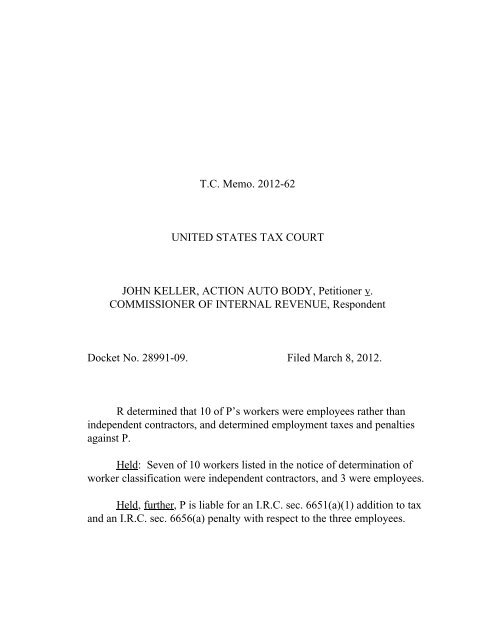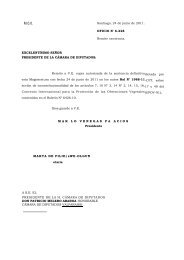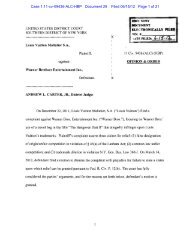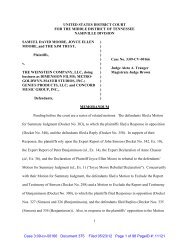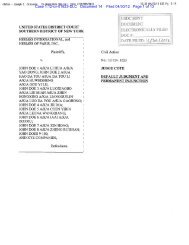John Keller, Action Auto Body v. Commissioner ... - U.S. Tax Court
John Keller, Action Auto Body v. Commissioner ... - U.S. Tax Court
John Keller, Action Auto Body v. Commissioner ... - U.S. Tax Court
Create successful ePaper yourself
Turn your PDF publications into a flip-book with our unique Google optimized e-Paper software.
T.C. Memo. 2012-62<br />
UNITED STATES TAX COURT<br />
JOHN KELLER, ACTION AUTO BODY, Petitioner v.<br />
COMMISSIONER OF INTERNAL REVENUE, Respondent<br />
Docket No. 28991-09. Filed March 8, 2012.<br />
R determined that 10 of P’s workers were employees rather than<br />
independent contractors, and determined employment taxes and penalties<br />
against P.<br />
Held: Seven of 10 workers listed in the notice of determination of<br />
worker classification were independent contractors, and 3 were employees.<br />
Held, further, P is liable for an I.R.C. sec. 6651(a)(1) addition to tax<br />
and an I.R.C. sec. 6656(a) penalty with respect to the three employees.
- 2 -<br />
<strong>John</strong> <strong>Keller</strong>, pro se.<br />
Michael K. Park, for respondent.<br />
MEMORANDUM FINDINGS OF FACT AND OPINION<br />
WHERRY, Judge: This case is before the <strong>Court</strong> on a petition for review of a<br />
notice of determination of worker classification for petitioner’s 1998 tax year which<br />
also determined that petitioner was liable for a $97,421.38 deficiency and $26,365<br />
in penalties and additions to tax. The issues for decision are:<br />
(1) whether the workers listed in the notice of determination should be<br />
legally classified as petitioner’s employees for Federal employment tax purposes;<br />
(2) whether petitioner is entitled to relief under the Revenue Act of 1978,<br />
Pub. L. No. 95-600, sec. 530, 92 Stat. at 2885, as amended (section 530), which in<br />
certain circumstances deems an individual not to be an employee; 1<br />
(3) whether petitioner is liable for the employment taxes in the notice of<br />
determination;<br />
1<br />
Unless otherwise indicated, all section references are to the Internal Revenue<br />
Code of 1986, as amended and in effect for the taxable year at issue. The Rule<br />
references are to the <strong>Tax</strong> <strong>Court</strong> Rules of Practice and Procedure.
- 3 -<br />
(4) whether petitioner is liable for a section 6651(a)(1) addition to tax for<br />
failing to file Forms 941, Employer’s Quarterly Federal <strong>Tax</strong> Return, and a Form<br />
940, Employer’s Annual Federal Unemployment <strong>Tax</strong> Return;<br />
(5) whether petitioner is liable for a section 6656 penalty for failing to make<br />
timely deposits of employment taxes.<br />
FINDINGS OF FACT<br />
Some of the facts have been deemed stipulated pursuant to Rule 91(f) from<br />
respondent’s request for admissions when petitioner did not respond to a motion to<br />
show cause and the stipulated facts are so found. The stipulated facts, with<br />
accompanying exhibits, are incorporated in our findings by this reference. 2 At the<br />
time the petition was filed, petitioner resided in California.<br />
Petitioner was a 50% partner in <strong>Action</strong> <strong>Auto</strong> <strong>Body</strong> (AAB), which operated a<br />
paint and auto body shop. Petitioner’s uncle, David <strong>Keller</strong>, was the other 50%<br />
partner. Petitioner managed the daily operations of the business. AAB had a<br />
contract with Mercury Insurance to make estimates for repairs and then would often<br />
repair those vehicles. AAB also took in business outside of Mercury.<br />
2<br />
At trial petitioner objected to many of the paragraphs in the stipulation of<br />
facts and sought relief from the admissions, arguing that he did not respond in time<br />
because “I’ve been medicated for neuropathy and I can’t think, I can’t read, I can’t<br />
do driving [sic].” The <strong>Court</strong> denied petitioner’s motion for relief from stipulations.
- 4 -<br />
On September 3, 2009, respondent sent petitioner a notice of determination of<br />
worker classification for the 1998 tax year, determining that the following<br />
individuals for the quarters listed were to be legally classified as his employees:<br />
Individual 1st Quarter 2d Quarter 3d Quarter 4th Quarter<br />
Kevin Walker x x x x<br />
Tony Red x x x x<br />
Alex Martinez x x x x<br />
Javier Mendoza x x x x<br />
Tom Thompson x x<br />
Kurt Hirsh x x x x<br />
Walter Black<br />
x<br />
Eric Mark x x x x<br />
Lorna Dinger<br />
Nicole Gonzalez/<br />
Sandoval<br />
For three years before opening AAB, petitioner and Tony Red worked<br />
together repairing cars as independent contractors. Mr. Red was a mechanic and<br />
also restored cars. Kevin Walker, Javier Mendoza, and Walter Black worked as<br />
auto body repair technicians for AAB. Alex Martinez worked as a detailer for<br />
AAB. Tom Thompson and Kurt Hirsch worked as auto body painters for AAB.<br />
Each of these seven auto body workers had his own space on AAB’s premises to<br />
x<br />
x
- 5 -<br />
perform his work but did not pay any rent. Petitioner paid all of AAB’s auto<br />
workers weekly by check; the amount varied depending on commissions and the<br />
type of work they performed.<br />
Eric Mark started out by cleaning the shop and assisting other workers at<br />
AAB and moved up to writing estimates for repairs. Mr. Mark received on-the-job<br />
training from petitioner and the other technicians at AAB. Petitioner also paid Mr.<br />
Mark weekly by check.<br />
Lorna Dinger and Nicole Gonzalez performed secretarial duties for AAB<br />
such as serving as a receptionist, answering the phones, and filing. Petitioner paid<br />
them weekly by check.<br />
Petitioner did not withhold any payroll tax from the amounts paid to any of<br />
the workers at AAB and did not issue Forms W-2, Wage and <strong>Tax</strong> Statement, or<br />
Forms 1099-MISC, Miscellaneous Income. AAB did not issue any employee<br />
manuals, and no employment contracts were ever signed between the workers of<br />
AAB and AAB.<br />
OPINION<br />
I. Burden of Proof<br />
As a general rule, the <strong>Commissioner</strong>’s determination of a taxpayer’s liability<br />
is presumed correct, and the taxpayer bears the burden of proving that the
- 6 -<br />
determination is improper. See Rule 142(a); Welch v. Helvering, 290 U.S. 111, 115<br />
(1933); Ewens & Miller, Inc. v. <strong>Commissioner</strong>, 117 T.C. 263, 268 (2001) (citing<br />
Boles Trucking Inc. v. United States, 77 F.3d 236, 239-240 (8th Cir. 1996) (this<br />
principle applies to determinations that a taxpayer’s workers are employees)).<br />
However, pursuant to section 7491(a), the burden of proof on factual issues that<br />
affect the taxpayer’s tax liability may be shifted to the <strong>Commissioner</strong> where the<br />
“taxpayer introduces credible evidence with respect to * * * such issue .” The<br />
burden will shift only if the taxpayer has, inter alia, complied with substantiation<br />
requirements pursuant to the Code and “cooperated with reasonable requests by the<br />
Secretary for witnesses, information, documents, meetings, and interviews”. Sec.<br />
7491(a)(2)(B). Petitioner failed to cooperate, and the burden of proof remains on<br />
him.<br />
II.<br />
The Workers’ Legal Classification<br />
Whether an individual is an independent contractor or an employee is a<br />
question of fact. Weber v. <strong>Commissioner</strong>, 103 T.C. 378, 386 (1994), aff’d, 60 F.3d<br />
1104 (4th Cir. 1995); Prof’l & Exec. Leasing, Inc. v. <strong>Commissioner</strong>, 89 T.C. 225,<br />
232 (1987), aff’d, 862 F.2d 751 (9th Cir. 1988). Common law rules are applied to<br />
determine whether an individual is an employee or an independent contractor. Secs.
- 7 -<br />
3121(d)(2), 3306(i); Nationwide Mut. Ins. Co. v. Darden, 503 U.S. 318, 322-323<br />
(1992).<br />
In determining whether a worker is a common law employee or an<br />
independent contractor, the <strong>Court</strong>, inter alia, generally considers: “(1) The degree<br />
of control exercised by the principal; (2) which party invests in work facilities used<br />
by the individual; (3) the opportunity of the individual for profit or loss; (4) whether<br />
the principal can discharge the individual; (5) whether the work is part of the<br />
principal’s regular business; (6) the permanency of the relationship; and (7) the<br />
relationship the parties believed they were creating.” See Ewens & Miller, Inc. v.<br />
<strong>Commissioner</strong>, 117 T.C. at 270; secs. 31.3121(d)-1(c)(2), 31.3401(c)-1(b),<br />
Employment <strong>Tax</strong> Regs. . This list of factors is not exclusive, and other factors may<br />
also be considered such as the provision of employee benefits. Weber v.<br />
<strong>Commissioner</strong>, 103 T.C. at 387, 393-394; Prof’l & Exec. Leasing, Inc. v.<br />
<strong>Commissioner</strong>, 89 T.C. at 232 (citing United States v. Silk, 331 U.S. 704, 716<br />
(1947)). All of the facts and circumstances of each case are considered, and no<br />
single factor is dispositive. Ewens & Miller, Inc. v. <strong>Commissioner</strong>, 117 T.C. at 270.
- 8 -<br />
A. Degree of Control<br />
The right of the principal to exercise control over the agent, whether or not<br />
the principal in fact does so, is the “crucial test” for the employer-employee<br />
relationship. Weber v. <strong>Commissioner</strong>, 103 T.C. at 387. “The employment<br />
relationship exists when the principal retains the right to direct the manner in which<br />
the work is done, and to control the methods used in doing the work, and to control<br />
the details and means by which the desired result is accomplished.” Ellison v.<br />
<strong>Commissioner</strong>, 55 T.C. 142, 152-153 (1970). In order to show the requisite degree<br />
of control, “the alleged employer need not ‘stand over the employee and direct<br />
every move that he makes.’” Simpson v. <strong>Commissioner</strong>, 64 T.C. 974, 985 (1975).<br />
Petitioner argues that he could not control the persons working for AAB and<br />
that they set their own hours and chose their own work. Petitioner credibly testified<br />
that “each outside service provider provided an individual direct service, from<br />
pinstriping to windows to glass to bumper repair to bumpers” and that the<br />
individuals worked at their own pace with their own methods to create a finished,<br />
deliverable product.
- 9 -<br />
Petitioner did not control the workers engaged in the actual body work of<br />
AAB. As the person for whom the services were performed, in order for the<br />
workers to be employees petitioner needed to have<br />
“the right [whether or not exercised] to control and direct the individual<br />
who performs the services, not only as to the result to be accomplished<br />
by the work but also as to the details and means by which that result is<br />
accomplished. That is, an employee is subject to the will and control<br />
of the employer not only as to what shall be done but how it shall be<br />
done. * * *”<br />
See Simpson v. <strong>Commissioner</strong>, 64 T.C. at 984 (quoting section 31.3121(d)-1(c)(2),<br />
Employment <strong>Tax</strong> Regs.). This was simply not the case for those persons engaged in<br />
auto work at AAB.<br />
However, as to Mr. Mark and the two workers who performed secretarial<br />
duties, the record is extremely sparse on petitioner’s ability to control. It seems to<br />
show that petitioner had the right to control their work, and petitioner did not prove<br />
that he did not control their work. Accordingly, this factor weighs heavily in favor<br />
of independent contractor status for the auto workers and employee status for Ms.<br />
Dinger, Ms. Gonzalez, and Mr. Mark.<br />
B. Investment in Facilities<br />
The fact that a worker provides his or her own tools or owns a vehicle that is<br />
used for work is indicative of independent contractor status. Ewens & Miller, Inc.
- 10 -<br />
v. <strong>Commissioner</strong>, 117 T.C. at 271-272 (citing Breaux & Daigle, Inc. v. United<br />
States, 900 F.2d 49, 53 (5th Cir. 1990)). Additionally, maintenance of a home<br />
office is consistent with, but not determinative of, independent contractor status.<br />
Lewis v. <strong>Commissioner</strong>, T.C. Memo. 1993-635.<br />
Petitioner argues that each of the persons working at AAB owned his own<br />
tools. Unfortunately, the stipulation of facts, which became absolute when<br />
petitioner did not object to the Rule 91(f) motion, explicitly states that each of the<br />
listed workers did not own his own tools. At trial petitioner did not present any<br />
evidence contrary to the stipulation of facts besides his and Ms. Dinger’s testimony.<br />
Ms. Dinger stated that the workers owned their own hand tools but explained that<br />
AAB owned and maintained heavy equipment such as sprayers, a framing machine,<br />
and lift equipment. This <strong>Court</strong> finds it especially unconvincing that the two workers<br />
who performed secretarial tasks provided their own equipment. There is no<br />
evidence whether any of the workers maintained a home office. The <strong>Court</strong><br />
concludes that this factor weighs in favor of an employer-employee relationship for<br />
all of AAB’s workers.<br />
C. Opportunity for Profit or Loss<br />
Compensation on a commission basis is entirely consistent with an<br />
employer-employee relationship. Tex. Carbonate Co. v. Phinney, 307 F.2d 289,
- 11 -<br />
292 (5th Cir. 1962); Capital Life & Health Ins. Co. v. Bowers, 186 F.2d 943,<br />
944-945 (4th Cir. 1951). However, compensation in the form of commissions can<br />
also be indicative of independent contractor status. See Simpson v. <strong>Commissioner</strong>,<br />
64 T.C. at 988. In Simpson the <strong>Court</strong> found, inter alia, that because the worker’s<br />
opportunity for “profit or loss in any given year was solely dependent upon his own<br />
efforts and skill” he was an independent contractor. Id. Petitioner paid the auto<br />
body workers weekly with the amount depending on the commissions and the type<br />
of work they performed. Although the auto workers were paid on the basis of their<br />
own efforts and skill, they were not entirely dependent on themselves because<br />
petitioner was responsible for finding most of the work. Nevertheless, the auto<br />
body workers also obtained some of their own work independently from AAB.<br />
There is no evidence in the record as to how the compensation of Mr. Mark and the<br />
workers performing secretarial duties was determined. Accordingly, this factor is<br />
neutral for the auto workers and weighs in favor of employee status for Ms. Dinger,<br />
Ms. Gonzalez, and Mr. Mark.<br />
D. Right To Discharge<br />
Employers typically have the power to terminate employees at will. Ellison v.<br />
<strong>Commissioner</strong>, 55 T.C. at 155. At trial petitioner explained that as to the persons<br />
working at AAB “could they be discharged by me? Absolutely. If I didn’t like
- 12 -<br />
their service or we were done for whatever reason”. Accordingly, the <strong>Court</strong><br />
concludes that this factor weighs in favor of an employer-employee<br />
relationship.<br />
E. Integral Part of Business<br />
Before the workers listed in the notice of determination began working at<br />
AAB, petitioner performed all of the services himself. However, once the business<br />
expanded, petitioner needed the flexibility of independent workers to handle the<br />
varying types of jobs and numbers of cars. Because petitioner paid the auto workers<br />
commissions based on the work they did, he could support different amounts of<br />
business. As the business expanded the workers became an important part of AAB.<br />
We note that when workers are an essential part of the taxpayer’s normal operations<br />
the <strong>Court</strong> has found this factor to weigh in favor of an employer-employee<br />
relationship. See Day v. <strong>Commissioner</strong>, T.C. Memo. 2000-375. However this case<br />
is distinguishable from Day because petitioner’s main job was to estimate repairs for<br />
Mercury Insurance, and he would then refer vehicles to the workers for repairs.<br />
The <strong>Court</strong> concludes that this factor is neutral. The business could have<br />
survived without the workers; the workers had previously survived and in the future<br />
could and did survive without AAB. Petitioner was capable of performing
- 13 -<br />
the services on his own and could have cut back the number of vehicles he took in<br />
to accommodate his loss of workers. Alternatively he could have referred or<br />
subcontracted the repair work out to other independent contractors. Therefore this<br />
factor indicates neither independent contractor nor employee status.<br />
F. Permanency of the Relationship<br />
A transitory work relationship may weigh in favor of independent contractor<br />
status. Ewens & Miller, Inc. v. <strong>Commissioner</strong>, 117 T.C. at 273 (citing Herman v.<br />
Express Sixty-Minutes Delivery Serv., Inc., 161 F.3d 299, 305 (5th Cir. 1998)).<br />
The principal’s right to discharge the worker, and the worker’s right to quit, at any<br />
time, is a factor. Id. The workers at AAB were all allowed to leave or quit at will,<br />
and some did. They could also have been discharged at will. At least six body<br />
workers left, and respondent treated them as independent contractors. Because both<br />
independent contractors and employees can be terminated at will, we accord this<br />
factor less weight. See Lewis v. <strong>Commissioner</strong>, T.C. Memo. 1993-635 (citing<br />
Neely v. <strong>Commissioner</strong>, T.C. Memo. 1978-18). Accordingly, this factor weighs<br />
slightly in favor of independent contractor status.<br />
G. Relationship the Parties Thought They Created<br />
Petitioner certainly thought that he was creating independent contractor<br />
relationships with workers at AAB. For three years before opening AAB,
- 14 -<br />
petitioner and Mr. Red had worked together repairing cars as independent<br />
contractors. The former workers who testified seemed aware that petitioner<br />
believed that they were independent contractors while working for him, and they<br />
agreed. Thus, the <strong>Court</strong> concludes that both petitioner and the AAB workers listed<br />
in the notice of determination intended to create independent contractor<br />
relationships.<br />
H. Provision of Employee Benefits<br />
Petitioner did not offer the workers listed in the notice of determination any<br />
employee benefits. Benefits are typically provided to employees rather than<br />
independent contractors. See Weber v. <strong>Commissioner</strong>, 103 T.C. at 393-394. When<br />
AAB closed or a worker left, none of the workers claimed unemployment benefits<br />
under California law. Accordingly, this factor tends to weigh in favor of<br />
independent contractor status.<br />
I. Conclusion<br />
After weighing the above factors, the <strong>Court</strong> concludes that the auto body<br />
repair workers listed in the notice of determination were independent contractors<br />
and Ms. Dinger, Ms. Gonzalez, and Mr. Mark were employees.
- 15 -<br />
III. Section 530 Relief<br />
Respondent also determined that petitioner is not entitled to relief from<br />
employee classification of its workers under section 530.<br />
Section 530(a)(1) provides that an individual will be deemed not to be an<br />
employee of a taxpayer for purposes of applying employment taxes to that taxpayer,<br />
if the taxpayer satisfies three requirements: (1) the taxpayer must not have treated<br />
the individual as an employee for any period; (2) the taxpayer must have<br />
consistently treated the individual as not being an employee on all tax returns for<br />
periods after December 31, 1978; (3) the taxpayer must have had a reasonable basis<br />
for not treating the individual as an employee. Joseph M. Grey Pub. Accountant,<br />
P.C. v. <strong>Commissioner</strong>, 119 T.C. 121, 130 (2002), aff’d, 93 Fed. Appx. 473 (3d Cir.<br />
2004).<br />
Respondent concedes that petitioner meets the first requirement because he<br />
did not treat any of the workers as employees for any period. Respondent, however,<br />
contends that petitioner failed to meet the second requirement because he never filed<br />
Forms 1099-MISC for any of the workers in question as required by sections<br />
6041(a) and 6041A(a). We note that “For tax periods after December 31, 1978,<br />
relief under § 530 is available only if<br />
* * * [the taxpayer] filed required tax or<br />
information returns. § 530(a)(1)”. Gen. Inv. Corp. v. United States, 823 F.2d 337,
- 16 -<br />
341 (9th Cir. 1987). To qualify for relief under section 530(a)(1), a taxpayer must<br />
satisfy all three requirements; and because we have found that petitioner fails to<br />
meet the second requirement, he does not qualify for relief under section 530. See<br />
Joseph M. Grey Pub. Accountant, P.C. v. <strong>Commissioner</strong>, 119 T.C. at 130.<br />
IV.<br />
Employment <strong>Tax</strong>es<br />
Because this <strong>Court</strong> found that three persons, Ms. Dinger, Ms. Gonzalez, and<br />
Mr. Mark, listed in the notice of determination were his employees and he did not<br />
present any evidence that the amounts of employment tax listed in the notice of<br />
determination were incorrect, petitioner is liable for the employment taxes related to<br />
those three employees. 3<br />
V. Section 6651 Addition To <strong>Tax</strong> and Section 6656 Penalty<br />
Under section 6656(a), if a taxpayer fails to make a required deposit on the<br />
date prescribed for that deposit, a penalty equal to the applicable percentage of the<br />
amount of the underpayment, determined pursuant to section 6656(b), shall be<br />
imposed. Section 6656(a) also provides that the penalty shall not be imposed if “it<br />
3<br />
We note that under sec. 3402(d) respondent will abate these taxes to the<br />
extent that the employees paid the tax and petitioner shows the taxes have been paid<br />
by these three employees. See Cain v. <strong>Commissioner</strong>, T.C. Memo. 2009-54; sec.<br />
31.3402(d)-1, Employment <strong>Tax</strong> Regs.
- 17 -<br />
is shown that such failure is due to reasonable cause and not due to willful neglect”.<br />
Likewise section 6651(a)(1) imposes an addition to tax for failure to timely file the<br />
tax return. 4 This addition to tax is also not to be imposed if the failure to pay was<br />
due to reasonable cause and not willful neglect.<br />
Although we did find that certain of petitioner’s workers were independent<br />
contractors and others were employees, we do not find that he had reasonable cause<br />
for failing to make the required deposits and timely pay tax for the three employees.<br />
As discussed supra petitioner did not issue a Form W-2 or a Form 1099-MISC to<br />
any of his workers, and it would be inconsistent for us to find that petitioner did not<br />
have reasonable cause for treating his employees as independent contractors but had<br />
reasonable cause for failing to make the required deposits and timely pay tax.<br />
Petitioner also did not provide any evidence of or explanation as to reasonable cause<br />
at trial. Petitioner is liable for the section 6656(a) penalty and the section<br />
6651(a)(1) addition to tax for the three workers that this <strong>Court</strong> has found to be<br />
employees.<br />
4<br />
We note that if the taxpayer has failed to file a return the tax may be<br />
assessed at any time. Sec. 6501(c)(3).
- 18 -<br />
The <strong>Court</strong> has considered all of the parties’ contentions, arguments, requests,<br />
and statements. To the extent not discussed herein, we conclude that they are<br />
meritless, moot, or irrelevant.<br />
To reflect the foregoing,<br />
Rule 155.<br />
Decision will be entered under


